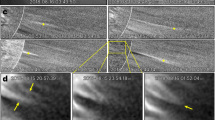Abstract
Flares and X-ray jets on the Sun arise in active regions where magnetic flux emerges from the solar interior amd interacts with the ambient magnetic field1,2. The interactions are believed to occur in electric current sheets separating regions of opposite magnetic polarity. The current sheets located in the corona or upper chromosphere have long been thought to act as an important source of coronal heating3,4,5,6, requiring their location in the corona or upper chromosphere. The dynamics and energetics of these sheets are governed by a complex magnetic field structure that, until now, has been difficult to measure. Here we report the determination of the full magnetic vector in an interaction region near the base of the solar corona. The observations reveal two magnetic features that characterize young active regions on the Sun: a set of rising magnetic loops and a tangential discontinuity of the magnetic field direction, the latter being the observational signature of an electric current sheet. This provides strong support for coronal heating models based on the dissipation of magnetic energy at current sheets.
This is a preview of subscription content, access via your institution
Access options
Subscribe to this journal
Receive 51 print issues and online access
$199.00 per year
only $3.90 per issue
Buy this article
- Purchase on Springer Link
- Instant access to full article PDF
Prices may be subject to local taxes which are calculated during checkout




Similar content being viewed by others
References
Yokoyama, T. & Shibata, K. Magnetic reconnection as the origin of X-ray jets and H-alpha surges in the Sun. Nature 375, 42–44 (1995)
Lites, B. W., Skumaniah, A. & Martínez Pillet, V. Vector magnetic fields of emerging solar flux. I. Properties at the site of emergence. Astron. Astrophys. 333, 1053–1068 (1998)
Parker, E. N. Magnetic neutral sheets in evolving fields—Part One—General theory. Astrophys. J. 264, 635–641 (1983)
Parker, E. N. Magnetic neural sheets in evolving fields—Part Two—Formation of the solar corona. Astrophys. J. 264, 642–647 (1983)
Parker, E. N. Nanoflares and the solar X-ray corona. Astrophys. J. 330, 474–479 (1988)
Ulmschneider, P., Priest, E. R. & Rosner, R. (eds) Mechanism of Chromospheric and Coronal Heating Ch. 4 (Springer, Berlin/Heidelberg/New York, 1991)
Mártinez Pillet, V. et al. in ASP Conf. Ser. 183. High Resolution Solar Physics: Theory, Observation, and Techniques 264 (Astronomical Society of the Pacific, San Francisco, California, 1999)
Harvey, J. & Hall, D. in IAU Symp. 43. Solar Magnetic Fields (ed. Howard, R.) 279–288 (Dordrecht, Reidel, 1971)
Penn, M. J. & Kuhn, J. R. Imaging spectropolarimetry of the He I 1083 nanometer line in a flaring solar active region. Astrophys. J. 441, L51–L54 (1995)
Rüedi, I., Solanki, S. K. & Livingston, W. C. Infrared lines as probes of solar magnetic features. X. He I 10830A as a diagnostic of chromospheric magnetic fields. Astron. Astrophys. 293, 252–262 (1995)
Rüedi, I., Keller, C. U. & Solanki, S. K. Measurements of the full Stokes vector of He I 10830 A. Sol. Phys. 164, 265–275 (1996)
Handy, B. N. et al. The transition region and coronal explorer. Sol. Phys. 187, 229–260 (1999)
Schmidt, W., Muglach, K. & Knölker, M. Free-fall downflow observed in He I 1083.0 nanometers and Hβ. Astrophys. J. 544, 567–571 (2000)
Zirin, H. & Wang, H. Narrow lanes of transverse magnetic field in sunspots. Nature 363, 426–428 (1993)
Galsgaard, K. & Longbottom, A. W. Formation of solar prominences by flux convergence. Astrophys. J. 510, 444–459 (1999)
Gudiksen, B. V. & Nordlund, Å. Bulk heating and slender magnetic loops in the solar corona. Astrophys. J. 572, L113–L116 (2002)
Ruiz Cobo, B. & del Toro Iniesta, J. C. Inversion of Stokes profiles. Astrophys. J. 398, 375–385 (1992)
Frutiger, C., Solanki, S. K., Fligge, M. & Bruls, J. H. M. J. Properties of the solar granulation obtained from the inversion of low spatial resolution spectra. Astron. Astrophys. 358, 1109–1121 (2000)
Kurucz, R. L. ‘Finding’ the ‘Missing’ solar ultraviolet opacity. Rev. Mexicana Astron. Astrofis. 23, 181–186 (1992)
Avrett, E. H., Fontenla, J. M. & Loeser, R. in IAU Symp. 154. Infrared Solar Physics (ed. Rabin, D. M.) 35–47 (Kluwer Academic, Dordrecht, 1994)
Giovanelli, R. G. & Hall, D. The helium 10830 A line in the undisturbed chromosphere. Sol. Phys. 52, 211–228 (1977)
Rachkowsky, D. N. The reduction for anomalous dispersion in the theory of the absorption line formation in a magnetic field [in Russian]. Izv. Krym. Astrofiz. Obs. 37, 56–61 (1967)
Trujillo Bueno, J., Landi Degl'Innocenti, E., Collados, M., Merenda, L. & Manso Sainz, R. Selective absorption processes as the origin of puzzling spectral line polarization from the Sun. Nature 415, 403–406 (2002)
Lagg, A., Woch, J., Krupp, N. & Solanki, S. K. Retrieval of the full magnetic vector with the He I multiplet at 1083 nm. Astron. Astrophys. (submitted)
Acknowledgements
M.C. acknowledges support from the Spanish Ministerio de Ciencia y Tecnologia. We thank the Kiepenheuer Institut in Freiburg, Germany, for observing support.
Author information
Authors and Affiliations
Corresponding author
Ethics declarations
Competing interests
The authors declare that they have no competing financial interests.
Rights and permissions
About this article
Cite this article
Solanki, S., Lagg, A., Woch, J. et al. Three-dimensional magnetic field topology in a region of solar coronal heating. Nature 425, 692–695 (2003). https://doi.org/10.1038/nature02035
Received:
Accepted:
Issue Date:
DOI: https://doi.org/10.1038/nature02035
This article is cited by
-
Magnetic imaging of the outer solar atmosphere (MImOSA)
Experimental Astronomy (2022)
-
Flare Observations
Living Reviews in Solar Physics (2017)
-
Radiative Diagnostics in the Solar Photosphere and Chromosphere
Space Science Reviews (2017)
-
Solar Science with the Atacama Large Millimeter/Submillimeter Array—A New View of Our Sun
Space Science Reviews (2016)
-
The magnetic field in the solar atmosphere
The Astronomy and Astrophysics Review (2014)
Comments
By submitting a comment you agree to abide by our Terms and Community Guidelines. If you find something abusive or that does not comply with our terms or guidelines please flag it as inappropriate.



